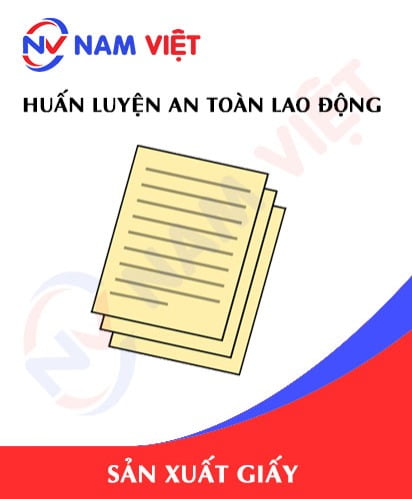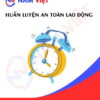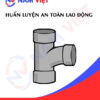Occupational Safety Training in Paper Manufacturing
99,000 ₫
Note: The above price is calculated for one person, the price may fluctuate depending on the number of trainees participating in the course and the dynamics of the market. For more accurate price support, please refer to the quotation table or contact our consulting staff directly.
Occupational safety is an important issue in paper manufacturing factories and needs to be addressed promptly to ensure the health and safety of workers, as well as to enhance the reputation of businesses. The Occupational safety training course is one of the effective solutions to raise awareness of accident prevention for workers participating in paper manufacturing in industrial parks.
Table of Contents
Toggle1. Overview of Paper
a. What is paper?
- Paper is a flat, thin material usually made from wood, straw, bagasse, cotton, flax, silk fibers, cloth, or other plant materials. Paper is manufactured by soaking these materials in water to separate wood pulp, fibers, or cellulose from the rest of the plant, then pressing and drying to create the final paper product.
- Paper is widely used for various purposes such as writing, printing, packaging, hygiene, and many other applications. Different types of paper are manufactured with different properties such as thickness, strength, whiteness, smoothness, gloss, water absorption, and printability.
- The paper manufacturing industry in Vietnam is currently developing strongly and contributes significantly to the national economy. As of 2021, Vietnam had about 1,000 enterprises operating in the paper manufacturing sector, producing around 5 million tons of paper per year.
- The paper manufacturing sector in Vietnam faces several challenges, including instability in raw material supply due to the nature of forestry crops, competition from imported paper products, and increasing demand for environmental protection. However, with government support and efforts from enterprises in the industry, the paper manufacturing sector in Vietnam continues to grow and make a significant contribution to the national economy.

b. Paper manufacturing machinery
The types of machinery used in paper manufacturing include:
- Paper pressing machine: a machine that uses pressure to press cellulose fibers or other paper materials into paper sheets.
- Paper cutting machine: a machine used to cut paper into different sizes and shapes.
- Paper treatment machine: a machine used to treat the surface of paper to improve gloss, smoothness, and whiteness.
- Printing machine: a machine used to print images, text, and graphics on paper surfaces.
- Paper recycling machine: a machine used to recycle used paper products into new paper products.
- Paper gluing machine: a machine used to glue paper sheets together or attach paper to other surfaces such as packaging materials or cardboard boxes.
- Laminating machine: a machine used to laminate a protective film on paper surfaces to protect the product and enhance paper gloss.
These machines are used in different paper manufacturing processes depending on the type of paper product and its intended use.

c. Typical paper manufacturing companies
Typical paper manufacturing companies in Vietnam include:
- Vina Kraft Paper Co., Ltd: one of the largest paper manufacturing companies in Vietnam, producing about 400,000 tons of paper per year. The company specializes in high-quality packaging paper products.
- Tan Mai Paper Joint Stock Company: a leading company in the paper manufacturing sector in Vietnam, producing around 200,000 tons of paper per year. The company specializes in packaging paper, printing paper, and label paper.
- Saigon Paper Corporation: one of the largest paper manufacturing enterprises in Vietnam, producing about 200,000 tons of paper per year. The company specializes in packaging paper, toilet paper, and writing paper.
- Hapaco Group: a diversified paper manufacturing corporation, including packaging paper, toilet paper, and printing paper. Hapaco Group produces about 150,000 tons of products per year.
- Lee & Man Vietnam: a branch of Lee & Man Paper Group (Hong Kong), specializing in packaging and printing paper. Lee & Man Vietnam produces about 300,000 tons of products per year.
- SCG Packaging: a subsidiary of SCG Group (Thailand), specializing in packaging paper and other packaging products. SCG Packaging produces about 200,000 tons of products per year.
- Nippon Paper Industries: a Japanese paper manufacturing company, producing about 140,000 tons of products per year. The company specializes in packaging and printing paper.
- Oji Group: a multinational paper manufacturing corporation from Japan, producing about 50,000 tons of products per year in Vietnam. The company specializes in packaging and printing paper.
d. Specific jobs in a paper manufacturing factory
Group 1
- Chief Executive Officer, Deputy CEO, department heads in the paper manufacturing factory.
Group 2
- Safety officers: manage safety in the factory, design safety procedures, supervise and ensure employees comply with safe working procedures.
Group 3
- Raw material preparation: raw materials needed for paper manufacturing such as wood, pulp, and chemicals are prepared and transported to the factory.
- Raw material processing: materials are processed to remove impurities and cut into small pieces for paper manufacturing.
- Pulp making: wood or cellulose materials are processed to produce pulp, treated with water, chemicals, and high temperature to separate paper fibers.
- Paper forming: this process involves feeding pulp into paper machines to create continuous paper sheets.
- Paper processing: paper is processed to create different products, including packaging paper, toilet paper, printing paper, and other types. This may include surface treatment, cutting, stacking, wrapping, and packaging.
- Quality control: paper is tested to ensure the product meets quality standards, including smoothness, strength, and load-bearing capacity.
- Equipment maintenance and repair: maintenance staff repair and maintain factory equipment to ensure efficient operation and employee safety.
Group 4
- Office, service, sales, and marketing jobs.
- Quality management, human resources management, material management, financial and accounting management.
- Production management: ensuring manufacturing processes follow procedures and achieve production targets, including managing staff, production planning, and monitoring production progress.
- Research and development of new products, designing product packaging samples.

2. Overview of occupational safety training in paper manufacturing
This article focuses on Group 3 because Group 3 is directly involved in the manufacturing process and is at the highest risk of occupational accidents. See other groups here.
a. What is Group 3 occupational safety training?
- Group 3 occupational safety training provides workers with awareness and skills to prevent occupational accidents.
- The training helps workers recognize and avoid hazards, reducing the risk of workplace accidents during manufacturing.
REGISTER FOR OCCUPATIONAL SAFETY TRAINING
b. Training duration
Initial occupational safety training
- Total training duration is at least 24 hours, including testing time.
- 8 hours theory on labor safety and hygiene laws and policies
- 8 hours theory on basic occupational safety and hygiene knowledge
- 4 hours theory on specialized occupational safety content
- 2 hours practice on specialized occupational safety content
- 2 hours theory test at the end of training
The safety training center will divide the time into multiple sessions depending on workers’ schedules. Usually, there are 6 sessions over 3 days, provided the factory arranges continuous training time.
Periodic occupational safety training
- Before the occupational safety card expires, workers seeking renewal must undergo periodic occupational safety training, with periodic training duration at least 50% of the initial training duration.
Explanation: total periodic occupational safety training duration is at least 12 hours, including testing time. After completing the periodic training and passing the test, workers are reissued and their occupational safety card is extended.
c. Training content
| No. | TRAINING CONTENT | TRAINING DURATION (HOURS) | |||
| Total | Including | ||||
| Theory | Practice | Test | |||
| I | Labor safety and hygiene laws and policies | 8 | 8 | 0 | 0 |
| 1 | Overview of labor safety and hygiene legal documents. | 6 | 6 | ||
| 2 | Standards and technical regulations on labor safety and hygiene. | 1 | 1 | ||
| 3 | Specific regulations by state management agencies on safety and hygiene when constructing, expanding, or renovating facilities for manufacturing, using, storing, and inspecting machines, equipment, materials, and substances with strict safety requirements. | 1 | 1 | ||
| II | Basic knowledge on occupational safety and hygiene | 8 | 8 | 0 | 0 |
| 1 | Basic knowledge of workplace hazards and harmful factors. | 4 | 4 | ||
| 2 | Methods to improve working conditions. | 1 | 1 | ||
| 3 | Safety culture in manufacturing and business. | 1 | 1 | ||
| 4 | Rights and responsibilities of employers and employees; policies on labor safety and hygiene; roles and responsibilities of safety networks and hygiene officers. | 1 | 1 | ||
| 5 | Safety and hygiene rules, signage, using safety equipment and personal protective equipment; occupational first aid and prevention of occupational diseases. | 1 | 1 | ||
| III | Specialized occupational safety content | 6 | 4 | 2 | 0 |
| Comprehensive knowledge of machines, equipment, and substances producing hazards; risk analysis, evaluation, management of occupational safety, safe working procedures with machines, equipment, and substances with strict safety requirements. | 6 | 4 | 2 | ||
| IV | End-of-course occupational safety test | 2 | 2 | 0 | 0 |
| Total | 24 | 22 | 2 | ||
See more training content of 6 groups
d. Occupational safety card
After completing the occupational safety training and passing the test, workers will be issued a Group 3 occupational safety card (commonly called Group 3 occupational safety certificate).
The Group 3 safety card clearly shows information such as full name, date of birth, job, and specific working environment. It also includes training duration, red stamp, and signature confirming course completion.
According to regulations in Clause 2, Article 24 of Decree 44/2016/ND-CP, there are two cases:
- If the employer and worker have a labor contract, the employer must stamp and certify the occupational safety card for Group 3 workers after completing training at an occupational safety training unit and passing the test.
- If the worker is freelance or seasonal, without a labor contract, the training unit must stamp and certify the safety card after the worker completes the training and passes the test.

3. Identifying Hazards in Paper Manufacturing
Paper manufacturing can bring many benefits to humans, but it also has many potential hazards. Below are some hazards in paper manufacturing:
- Paper manufacturing can cause environmental pollution, including emissions of gases and wastewater containing harmful chemicals such as chlorine, lead, and mercury. These substances can harm human health and cause environmental issues, including drought and soil subsidence.
- Some types of paper are made from wood, which can lead to excessive deforestation and damage the habitats of many animal species.
- Paper manufacturing involves many dangerous tasks, including operating large machinery, cutting paper, and handling hazardous chemicals. This can lead to occupational accidents and health issues for workers.
- Paper manufacturing requires large amounts of water and energy. This can lead to resource depletion and environmental issues, including droughts and power shortages.
- Paper manufacturing generates large amounts of waste, including dry pulp, sludge, and landfill waste. These wastes can pollute the environment and be harmful to humans and animals.
4. Common Occupational Accidents in Paper Manufacturing
Paper manufacturing is an industry with a high risk of occupational accidents. Some common types of accidents in paper manufacturing include:
- Accidents while operating machinery: Machines in a paper factory can cause serious accidents if not operated correctly or maintained regularly. These accidents can result in injuries or fatalities.
- Accidents while cutting paper: Cutting paper requires high concentration and precision. Improper handling, especially when using paper cutting machines, can cause injuries to workers.
- Chemical-related accidents: Paper manufacturing involves chemicals such as dyes, bleaches, and preservatives. Improper use or lack of protective gear can result in burns, skin irritation, or other health issues.
- Accidents while moving loads: Paper manufacturing requires moving large, heavy materials. Incorrect handling or lack of protective equipment can cause serious accidents, especially when using forklifts or cranes.
- Accidents at heights: Employees in paper factories often work on elevated platforms. Without proper training and safety equipment, workers may fall, risking serious injury or death.
5. Safety Measures for Paper Manufacturing
To ensure worker safety during paper manufacturing, the following safety measures should be implemented:
- Workers should be provided with full personal protective equipment, including helmets, safety glasses, gloves, safety shoes, masks, and other protective devices.
- Workers should receive proper occupational safety training covering safe work skills, use of protective equipment, and safe working methods.
- Machines and equipment in the paper factory should be regularly maintained to ensure safe operation. Workers should be trained to use equipment correctly and avoid working with faulty machinery.
- Paper factories must fully comply with occupational safety regulations, including hygiene, fire prevention, and incident management rules.
- Factories should monitor and analyze risks to identify hazards and apply appropriate safety measures.
- Investigate accidents and incidents to determine causes and prevent recurrence in the future.
- Enhance worker safety awareness by creating a safe work environment and encouraging educational activities about occupational safety.
- Regularly conduct workplace environment monitoring in factories, collect and analyze harmful factors, and adjust them to reduce risks, preventing occupational diseases.

6. Benefits of Occupational Safety Training in Paper Manufacturing
An Toan Nam Viet provides businesses with the following benefits after completing occupational safety training courses in compliance with Decree 44/2016/ND – CP regarding occupational safety and hygiene for companies, factories, and businesses:
- Workers can identify potential occupational hazards and take preventive measures to avoid accidents.
- Businesses can establish risk prevention measures in production, operation, and maintenance processes.
- Reduce costs associated with workplace safety risks.
- Uninterrupted production increases labor productivity and product quality.
- Compliance with occupational safety laws reduces legal risks.
- Enhances reputation and professionalism, thereby elevating the business brand.
An Toan Nam Viet’s training courses are solutions to prevent external hazards from affecting individuals, helping them avoid injuries or worse, fatalities.
REGISTER FOR OCCUPATIONAL SAFETY TRAINING SERVICE
7. Customer Feedback After Completing Paper Manufacturing Safety Training
An Toan Nam Viet has many years of experience accompanying businesses in Vietnam, both nationwide and in southern provinces. This responsibility is highly valuable to Nam Viet, which is why our Occupational Safety Training is increasingly professional. The motivation for An Toan Nam Viet’s growth comes from positive feedback and suggestions from businesses. Below are testimonials from partners we have served.
Hoa Dat Construction and Trading Joint Stock Company
“Nam Viet’s service has greatly helped us simplify occupational safety and complete safety documentation for our operations. The consulting team was responsive and timely to our questions. 5 stars for Nam Viet.”
See more customer interviews after using the service from An Toan Nam Viet
8. An Toan Nam Viet’s Occupational Safety Training Capability
An Toan Nam Viet is a reputable and quality occupational safety training center in Vietnam. Our courses are continuously conducted at manufacturing workshops, factories, or construction sites across all 63 provinces in Vietnam.
REGISTER FOR OCCUPATIONAL SAFETY TRAINING SERVICE
License for occupational safety training
- An Toan Nam Viet has been inspected and certified by the Department of Labor Safety under the Ministry of Labor – Invalids and Social Affairs, granting certification for occupational safety and hygiene training. This further strengthens our occupational safety training capability.

Materials and Lectures
- Before being used in occupational safety training courses, materials are reviewed and approved to ensure accuracy and effectiveness.
- Teaching methods of instructors follow An Toan Nam Viet standards, developed by experts in occupational safety and hygiene training to maximize knowledge absorption for trainees.
Facilities
- Controlling classroom factors that affect training improves teaching efficiency and trainee knowledge retention.
- Our training facilities include spacious classrooms meeting standards for area, lighting, and training equipment.
9. Nationwide Reputable Occupational Safety Training Center
At An Toan Nam Viet, we prioritize the professional training of occupational safety. Teaching workers how to protect themselves equips them with essential safety skills for their work life, contributing to national development.
To ensure effective training, we carefully prepare every detail, including tools, teaching equipment, curriculum, documents, sound, and lighting.
Our occupational safety instructors are experienced experts, some with research on hazard identification across industries and prevention methods.
Lectures are practical, engaging, and easy to understand, helping workers absorb knowledge effectively. Training strictly follows Decree 44/2016/ND-CP.
This equips workers with hazard prevention measures and self-protection skills applicable in real work scenarios.
Our training center proudly provides professional occupational safety training with advantages including:
- Competitive training costs with guaranteed quality.
- Flexible training schedule to match company manufacturing needs.
- Quick and legally compliant certification procedures.
- Instructors with many years of professional experience.
- Classrooms optimized for teaching efficiency and knowledge retention.
- Lectures tailored to occupational safety requirements in businesses.
- An Toan Nam Viet works dedicatedly and professionally to provide fast and accurate support to clients.

10. Additional References for Paper Manufacturing Safety Training
- Paper Manufacturing Occupational Safety Materials
- Occupational Safety Training Materials
- Occupational Safety Training Test Set
- Paper Manufacturing Occupational Safety Quiz
- Paper Manufacturing Occupational Safety Training Slides
1 review for Occupational Safety Training in Paper Manufacturing
No comments yet















namchinh.haiphong341
Bài giảng rất sinh động!